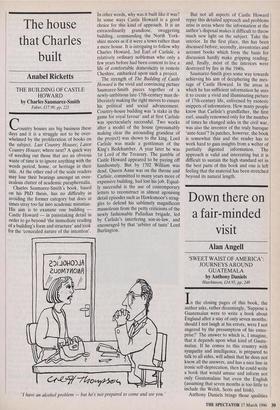The house that Charles built
Anabel Ricketts
THE BUILDING OF CASTLE HOWARD by Charles Saumarez-Smith
Faber, f17.99, pp. 221
Country houses are big business these days and it is a struggle not to be over- whelmed by the proliferation of books on the subject. Last Country Houses; Latest Country Houses; where next? A quick way of weeding out those that are an obvious waste of time is to ignore anything with the words period, home, or heritage in their title. At the other end of the scale readers may lose their bearings amongst an over- zealous clutter of academic paraphernalia.
Charles Saumarez-Smith's book, based on his PhD thesis, has no difficulty in avoiding the former category but does at times stray too far into academic minutiae. His aim is to examine one building Castle Howard — in painstaking detail in order to go beyond 'the immediate reading of a building's form and structure' and look for the 'concealed nature of the intention'. In other words, why was it built like it was? In some ways Castle Howard is a good choice for this kind of approach. It is an extraordinarily grandiose, swaggering building, commanding the North York- shire moors as if it were a town rather than a mere house. It is intriguing to follow why Charles Howard, 3rd Earl of Carlisle, a relatively ordinary nobleman who only a few years before had been content to live a life of comfortable domesticity in remote Cheshire, embarked upon such a project.
The strength of The Building of Castle Howard is the vivid and convincing picture Saumarez-Smith pieces together of a newly-ambitious late-17th-century man de- liberately making the right moves to ensure his political and social advancement. Country-house building was 'a stake in the game for royal favour' and at first Carlisle was spectacularly successful. Two weeks after a model of the house (presumably making clear the astounding grandeur of the project) was shown to the king, Lord Carlisle was made a gentleman of the King's Bedchamber. A year later he was 1st Lord of the Treasury. The gamble of Castle Howard appeared to be paying off handsomely. But by 1702 William was dead, Queen• Anne was on the throne and Carlisle, committed to many years more of expensive building, had lost his job. Equal- ly successful is the use of contemporary letters to reconstruct in almost agonising detail episodes such as Hawksmoor's strug- gles to defend his sublimely magnificent mausoleum from the petty criticisms of the newly fashionable Palladian brigade, led by Carlisle's interfering son-in-law, and encouraged by that 'arbiter of taste' Lord Burlington.
`I have an alcohol problem — but he's not prepared to come and see you.'
But not all aspects of Castle Howard repay this detailed approach and problems arise in areas where the information at the author's disposal makes it difficult to throw much new light on the subject. Take the interior. In the first place, this has been discussed before; secondly, inventories and account books which form the basis for discussion hardly make gripping reading; and, finally, most of the interiors were destroyed by fire in the 1940s.
Saumarez-Smith goes some way towards achieving his aim of deciphering the mes- sage of Castle Howard. In the areas in which he has sufficient information he uses it to create a vivid and illuminating picture of 17th-century life, enlivened by esoteric snippets of information. How many people know that Carlisle's grandfather, the first earl, usually renowned only for the number of times he changed sides in the civil war, was also the inventor of the truly baroque `ante-feast'? In patches, however, the book is somewhat thin and the reader has to work hard to gain insights from a welter of partially digested information. The approach is valid and interesting but it is difficult to sustain the high standard set in the best parts of this book and one is left feeling that the material has been stretched beyond its natural length.


























































 Previous page
Previous page